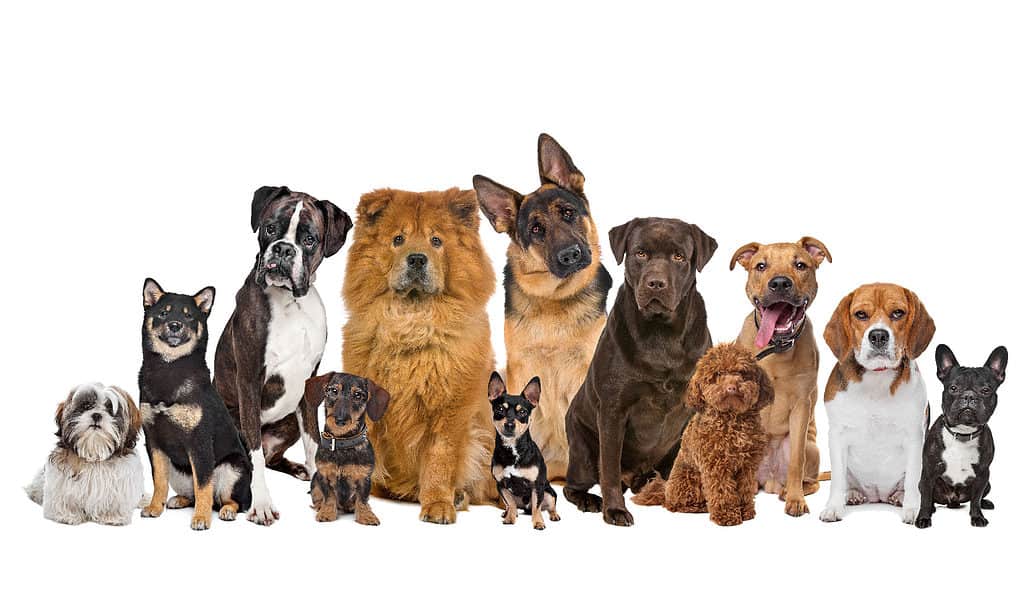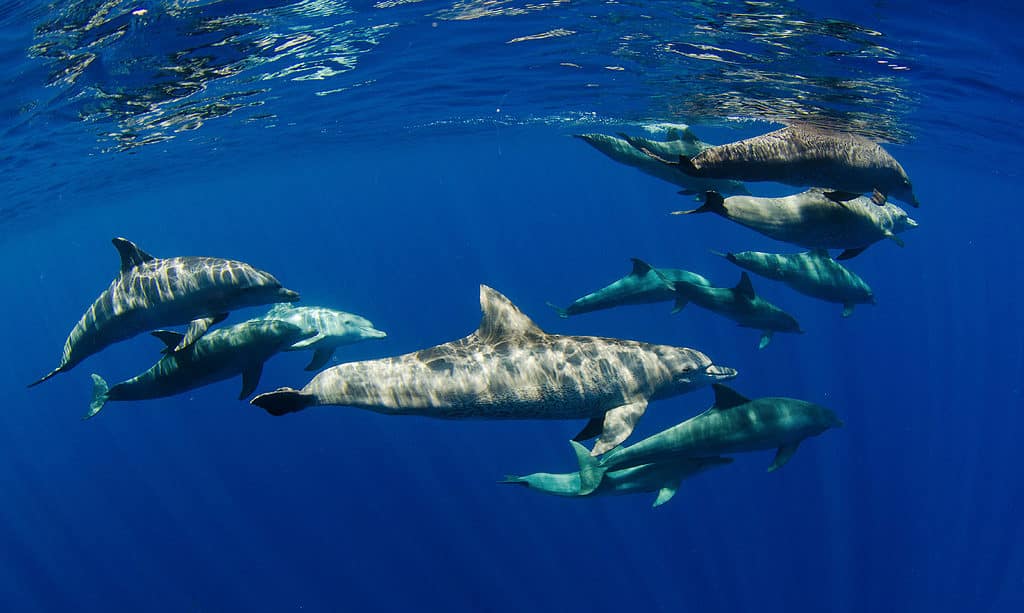Humans first domesticated animals over 10,000 years ago when agricultural communities began growing crops and raising livestock. Ever since, humans have had many interesting relationships with several animal species. Some animals possess unique abilities like a keen sense of smell, excellent hearing, or tremendous strength. Humans train animals to harness these abilities and exploit them for their own benefit. Animals have therefore played many critical roles throughout human history and continue to work for humans today. They serve humans in the realms of agriculture, warfare, security, hunting, healthcare, and more. This article will examine 6 animals that help people in fascinating ways!
Key Points
Animals that help humans
- Dogs
- Mercy Dogs
- Seeing Eye Dogs
- Police dogs
- Birds
- Falconry with Eagles
- Canaries in Mines
- Horses
- War Horses
- Agriculture, Livestock, and Transportation
- Marine Mammals: Dolphins and Sea Lions
- The U.S Navy Marine Mammal Program
Dogs

Humans have bred dogs for thousands of years selecting for smelling acuity, physical strength, size, and other traits that make them well suited for specific jobs.
©Erik Lam/Shutterstock.com
Dogs have a long history of helping people and have done so in a variety of roles. An important component of that long history is artificial breeding. Humans have bred dogs for thousands of years selecting for smelling acuity, physical strength, size, and other traits that make them well suited for specific jobs. There have been thousands of different working relationships between dogs and humans spanning from finding dead bodies in criminal cases, to making sure a disabled person knows when their blood sugar is low and that they have their medications. Since there are far too many roles dogs have played by human’s side to review in one sitting, here we discuss three that are particularly interesting.
Mercy Dogs
One interesting way dogs have helped people throughout history is by serving in the military as mercy dogs. Today, when people are lost on a battlefield or need urgent medical care in a combat zone, there is technology available to extract them as quickly and safely as possible. During World War I and World War II, much of this technology didn’t exist. Army medics were extremely vulnerable and soldiers with severe wounds could be stranded without care.
Mercy dogs prevented thousands of deaths by acting as battlefield paramedics. After active combat, mercy dogs would locate wounded soldiers and provide them with first aid supplies and liquor. If the mercy dog found a soldier that was too badly wounded to perform first aid themself, the dog would rip part of the soldier’s uniform off and run it back to base camp to alert the medics. Then, the dog would lead the medics back to the soldier for extraction.
Mercy dogs were incredibly well trained. They were taught to distinguish friendly and enemy soldiers’ uniforms and to distinguish severely wounded, unconscious people and dead bodies. When the dogs were searching, they would disregard all enemies or dead soldiers and focus their attention on finding living friendly ones. They were even known to pull the wounded away from battlefields while under fire.
Seeing Eye Dogs
Another impressive and better-known helpful dog is the seeing eye dog. The first record of a dog assisting a blind person is from 79 CE! In Pompeii, excavations reveal a mural of a blind man being led by his dog. There is also a reference to seeing eye dogs in a Chinese scroll from 1200 CE, and several more times throughout history. The first professionally trained and issued seeing eye dog was assigned to a blinded veteran in 1916. In the following year, 100 more guide dogs were issued, and by 1919, 539 dogs were helping American veterans. Guide dogs for civilian use in the U.S. were available in 1922.
As the name suggests, seeing eye dogs- also called guide dogs – facilitate blind people with various tasks. Most importantly, they allow for greater independence and mobility by assisting with navigation, avoiding hazards while walking, and getting to places without dependence on another person. This opens doors for social inclusion and avoiding a sedentary lifestyle. Today, people who qualify for a specially trained seeing-eye dog must be completely or partially blind, mobile, and physically healthy enough to care for a dog.
For people in other circumstances, there is special training for dogs to provide medical assistance in other ways. Emotional support dogs can train to identify panic attacks and ensure their owner doesn’t get hurt if they collapse. For epileptic people, a trained dog can identify the onset of a seizure and move their owner into the recovery position if they are seizing. Dogs can also retrieve medications, provide emotional support, and perform several other medical tasks.
Police Dogs
Roles
Although there are many other roles dogs play in the human world, the last we will discuss is that of the police dog. These canines have exceptional training and perform many tasks that are crucial to the safety of civilians and police officers. Police dogs have been helping people in this capacity since the early 14th century according to French records that describe policemen using dogs to assist guards at piers. Now, dogs work at polices’ sides around the world. Common tasks they perform include explosives detection, drug detection, tracking missing persons, finding human remains, and active criminal pursuit. Special training is required for most jobs, such as detecting narcotics or explosives.
Famous Police Dogs
One example of a famous police dog is a German shepherd from the Scottish police force, Luna. Luna retired in 2022 at the age of 10 after a long career of saving lives. The police accredit Luna with saving the lives of 38 people over 8 years! This dog-hero’s area of expertise was tracking high-risk missing people. In many cases, the missing people she was tracking were vulnerable to hypothermia and had pre-existing health issues that made their cases highly emergent.
Another famous police dog is Joker, a crucial former member of the Bradley County Police Department in Tennessee, USA, and the face of change in laws regarding police dogs. Joker was proficient in apprehension, narcotics, and tracking, and was known amongst criminal circles for his prowess. During a chase, however, Joker was deployed to apprehend suspects in a robbery and was severely wounded. He caught one of the suspects but was shot and the man escaped. Luckily, Joker recovered despite the severity of his wounds, but his assault did raise questions about laws protecting police dogs. At the time, wounding a police dog was punishable only as destruction of property. With Joker as the face of a movement, new legislation was passed making it a penalty of up to 30 years to shoot a police dog.
Birds

Hunting prey through the practice of falconry and detection of carbon monoxide in mines are two ways that birds have helped humans.
©Yongkiet Jitwattanatam/Shutterstock.com
Falconry
A very interesting, lesser-known example of a helpful relationship between man and beast is falconry. Falconry is the practice of hunting wild animals using trained birds of prey, like eagles. Highly trained eagles are loyal to a handler and will hunt prey such as foxes and hares. In Mongolia, there is a long history of falconry, and the Kazakh people continue eagle hunting practices there today. It is also seen throughout history in cave paintings from the Bronze age, and in records claiming Genghis Khan was an avid falconer. Also, in 1100 CE, Marco Polo was said to have gone eagle hunting with Khan’s grandson. The earliest record of falconry, however, is from 2,000 BC in Mesopotamia!
Canaries in Mines
Canaries are well-known for their iconic role helping detect carbon monoxide in mines. The popular idiom “canary in a coal mine”, meaning someone who warns others of danger, references this practice. The earliest use of canaries in mines was in 1896, and thereafter, miners would often bring canaries into mines to act as a warning signal for carbon monoxide toxicity. The canaries are much smaller than humans and they have very fast metabolisms. Consequently, they would succumb to the gaseous poison first and pass out. This would alert miners and give them time to escape before they too were overwhelmed by the gas. Carbon monoxide cannot be seen or smelt by humans so it can be very dangerous. In addition to canaries, many different animals have been used as sentinels in the past to detect gases.
Horses

Since domestication horses have become critical assets during war, for agricultural use, as transportation, and for other purposes.
©Callipso88/Shutterstock.com
The next animal that helps humans in important roles is the domesticated horse, Equus ferus caballus. Horses were first domesticated approximately 6,000 years ago! Before then, scientists believe humans likely hunted horses. Since domestication however, they have become critical assets during war, for agricultural use, as transportation, and for other purposes. The roles horses have played in early societies made important facets of human life more efficient. In many ways, horses led to the rise of powerful empires, such as the very first of its kind, the Akkadian Empire in 2350 BC. The first ruler, Sargon of Akkad, had horses leading up to and during his reign.
Horses were introduced to an older civilization, Mesopotamia, around this time as well and were a prominent status symbol. Horses were a symbol of wealth in many cultures and continue to be today because of their strength, utility, and beauty. As a form of wealth, they have been involved in trading and dowries as well. Horses are also relevant in human culture for entertainment in many forms. Dressage and show jumping are popular activities alongside polo, horse racing, and barrel running.
Transportation, Livestock, and Agriculture
Horses were first domesticated to be ridden. Humans 6,000 years ago began riding horses and were then able to maintain larger herds than they could whilst herding on foot. They also became more productive in agricultural endeavors. Horses could assist with manual labor that would otherwise be extremely strenuous including plowing and pulling carts carrying crops.
Some historians and scientists suggest horses, in part, led to the creation of nuclear families. A nuclear family consists only of a couple and their dependent children, as opposed to extended family or communal living. Families, as individual units, were able to break away from the larger group and disperse. They were more efficient in the fields and could handle more livestock thanks to horses. When they became self-sufficient, they no longer needed to rely on their community for resources and could live sustainably farther apart. People could also travel further and faster with horses. Riding horseback was long used for transportation and supported the formation of nuclear families.
War
Horses were first used in warfare for cavalry between 4,000 and 3,000 BC in Eurasia by equestrian nomads. Later, cavalry became a widespread, crucial component of warfare. Light cavalry consisting of fewer people performed reconnaissance, screening, and other tactical duties, and heavy cavalry could inflict larger scale attacks or ambushes.
The chariot was invented in Mesopotamia and was pivotal because of its use in warfare beginning in 3,000 BC. They were initially drawn by onagers, an Asiatic donkey species. Horse-drawn chariots were revolutionary because they provided greater mobility and longevity on the battlefield. Horses were first used as draft animals pulling chariots into battle later in 2,000 BC.
In Mesopotamia, chariots were manned by a by a spearman and a charioteer. Chariots were also famously used by pharaohs in the New Kingdom of Egypt, and by Babylonian royalty. Interestingly, the New Kingdom Egyptian military had a branch of their military called the chariotry, as well as an infantry and navy. Chariots were critical tools in many famous battles including the victories of the Hyksos in Egypt, the Mycenaeans in Greece, the Aryans in northern India, and elsewhere.
Marine Mammals

The U.S Navy employs bottlenose dolphins and sea lions in their Marine Mammal Program to perform specific tasks.
©Joost van Uffelen/Shutterstock.com
The final interesting working animals we will investigate today are bottlenose dolphins (Tursiops truncates) and California sea lions (Zalophus californicus). The U.S Navy employs the help of these unexpected animals in their Marine Mammal Program – move over Navy SEALs, meet the Navy dolphins and sea lions! The program was first established in Point Loma, California in the 1960s where it is still in operation. There are 5 marine mammal teams called MK 4, MK 5, and so on through MK 8 consisting of dolphins, sea lions, or both. They are trained to perform different specific tasks such as identifying and removing underwater explosives and retrieving equipment or training gear from the ocean. Although training marine mammals might be surprising, they are incredibly intelligent and have proven to be valuable assets.
Some examples of marine mammals in action include dolphins and sea lions in the Vietnam war, in the Persian Gulf during the Iraq war, and currently in California helping at training and testing areas. In the Vietnam war, team MK 6 was deployed as sentries protecting harbors and ships. During their first deployment, the team consisted of dolphins that attached devices to the oxygen tanks of enemy divers that would explode and float to the surface. Sea lions similarly were trained to handcuff buoyancy devices to enemy swimmers.
In the Persian Gulf in 2003, dolphins were critical to clearing mine fields and booby traps. They are credited with detecting over 100 anti-ship mines and booby traps at a single port there. In California, MK 5 works to recover training and testing equipment for the U.S. Navy. Their first major recovery was of an anti-submarine rocket from 50 meters deep in 1970. They can also retrieve dummies used in various exercises like a simulated airplane crash.
The photo featured at the top of this post is © iStock.com/TRAVELARIUM
FAQs (Frequently Asked Questions)
When were animals first domesticated?
Humans first domesticated animals over 10,000 years ago when agricultural communities began growing crops and raising livestock.
What are dogs bred for?
Dogs have a long history of helping people and have done so in a variety of roles. An important component of that long history is artificial breeding. Humans have bred dogs for thousands of years selecting for smelling acuity, physical strength, size, and other traits that make them well suited for specific jobs.
Thank you for reading! Have some feedback for us? Contact the AZ Animals editorial team.






